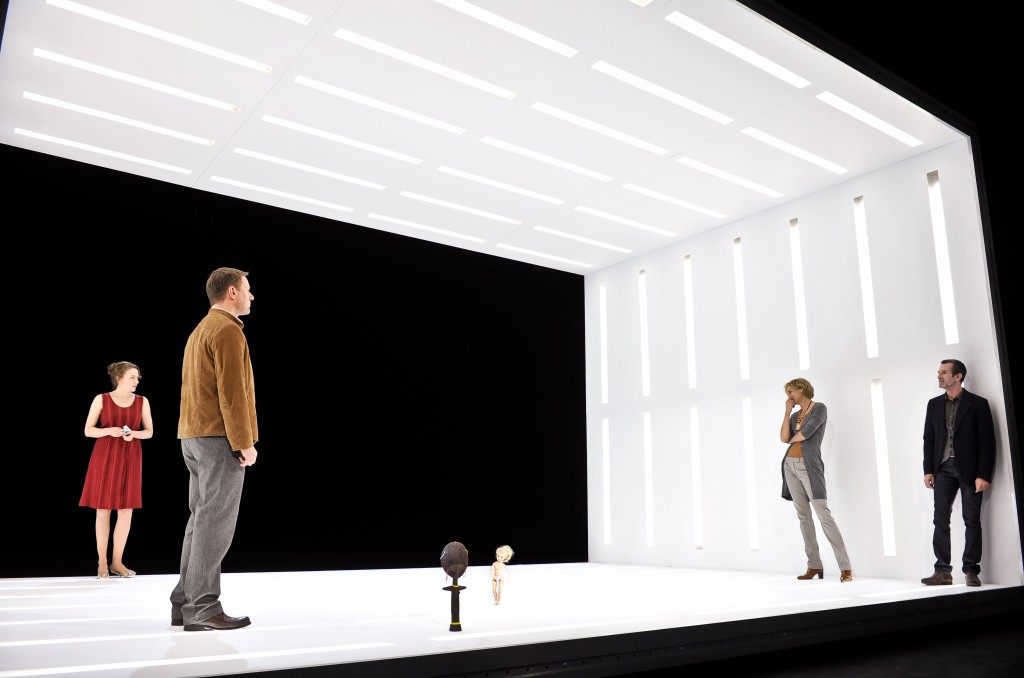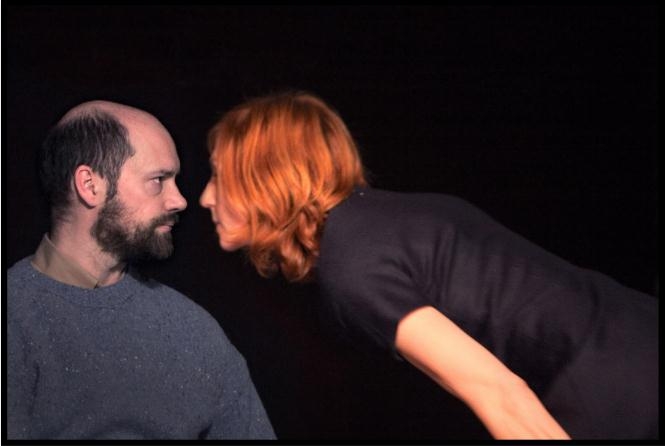(Above: Gift with Steven van Watermeulen and Elsie de Brauw)
Trying to point out what constitutes contemporary theatre is a difficult task. When I asked Johan Simons, artistic director of the ‘Münchner Kammerspiele’ (a theatre that is known for its up-to-date, experimental and avant-garde performances) in a talk on culture on February, 9th 2012 in Munich, he advocated the freedom of the arts instead, meaning not only the sujet of the plays, but also the way they are interpreted and performed on stage: “Each play speaks to you [to the director]. The story itself tells you how to organize it, where to put the emphasis on and what kind of atmosphere you can create with it. Theatre does not position itself in any specific movement, it is very diverse, and plurality is the thing that signifies it most.” As usual, directors and actors negate any kind of categorization of their work. Granted, the plays themselves and the ways they are presented seem to differ from each other much, but isn´t there any common thread that connects them all?
After decades in which plays were marked by association, citation and intertextuality, nowadays we appear to experience a comeback of a kind of play that puts the focus on logic, psychological motivation and straight-forward narration. In my opinion, what theater aims for is not simple provocation. Also, its aesthetic can no longer be reduced to being taboo-breaking and ‘risk-taking’[1]. Theatre turns towards ‘real’ people with real problems. The plays refer to more than just themselves, and in the process stories are created that have an effect on the viewer again. Those stories don´t allow the viewer to be distanced anymore. Heavily influenced by the experience of postmodern apathetic theater, contemporary drama tries to incorporate an ethical perspective again. Small stories about small communities relate to a bigger picture or as Christoph Henke and Martin Middeke put it: “[…] each drama, therefore, is a micro-society which interacts with the real one, albeit without being a simple reproduction of it.”[2]
The basic form of society is a family consisting of two parents and their child. In Gift [Poison] (2009), written by Dutch Lot Vekemans and directed by Johan Simons in the ‘Münchner Kammerspiele’, this little society is destroyed when the son dies in a fatal accident. The remaining parents split up, because they can’t stand their shared grief, and only meet again after nine years. In this meeting they attempt to negotiate their different ways of dealing with the tragedy. Their argument is full of bitter irony, but it seems to be the first time that they are truly honest with each other. Eventually, they achieve a kind of harmony that is based on an aesthetic experience that the husband encountered: When one time waiting for a choir session to start, he listens to a male voice singing the song “Let it be blues”. So touched by this, he wonders what would happen if his life would stay the way it is now: He feels he would be relieved by this intensive experience of presence. Now, in the argument with his ex-wife, he also remembers the last minutes with their son, when the mother sang a silent song for her dying child. In both cases a song comforted them. In the end, what they share on an aesthetic level becomes eventually more powerful than what separates them.
The return to clear-structured storylines – a set beginning and a definite ending – seems to be a return to traditional elements, but is, in fact, a very contemporary tendency. Birgit Haas calls this – in a purposely tautological way – ‘dramatic drama’[3]. Moreover, theatre regains its political responsibility back which was theatre´s main task from its beginning. Theatre´s political function is derived from ‘human interaction and personal conflicts’[4], the individual is re-installed as the active subject. By closely observing relationships between individuals the viewer can reconstruct how political structures are developed in an experimental playground.
This appears to be a step back to older forms of representation, when the individual was the centre of the play like in ancient Greek theatre. But, in fact, in this period of theatre the individual was only the victim of fate and had no possibility to act in a self-determined way. It also differs from a psychological theatre with a social background – as German drama was characterized around 1910 – which concentrated on an exact, detailed and subjective representation of reality without referring to its own limits. Therefore today´s plays cannot be simply brushed aside as being old-fashioned, rather theatre tries to defines itself anew. Nowadays, theatre understands itself again as a critical force that reveals and deals with society`s hidden power-structures, instead of simply giving up in face of an overcomplicated world.
The ‘dramatic drama’ tries to convey a concept of unity. The mosaic structure of postmodernism is not appropriate anymore to represent the current developments in culture, the ‘new’ theater feels the need to turn to seemingly ‘old’ traditions like mimesis, and the pristine urge to tell stories. The stage is not an open (postmodern) stage, rather it serves as a virtual closed space. Fiction is separated from reality again.
 (Above: Peggy Pickit with Maren Eggert, Norman Hacker, Sophie von Kessel, Ulrich Matthes)
(Above: Peggy Pickit with Maren Eggert, Norman Hacker, Sophie von Kessel, Ulrich Matthes)
Roland Schimmelpfennig`s play Peggy Pickit sieht das Gesicht Gottes [Peggy Pickit sees the face of God] (2010) directed by Martin Kušej in ‘Bayerisches Staatsschauspiel’ (a more traditional theatre in Munich) is an example for this kind of ‘new’ theatre.
This is shown best when looking at the play`s dialogic situation. The four characters have a conversation about the weather, about their past lives and when they´ve seen each other the last time. However, from time to time some fragments appear that don´t really belong or fit into the conversation. In addition, the characters often freeze like in a time-out. Characters act as if mediums of a message by an unknown sender.
These fragments will appear later again – this time making much more sense. Information of coming discussions are anticipated constantly. Interestingly, this doesn`t have a disrupting effect, rather a uniting one, because these little fragments will find their well-deserved place later by a re-constructive work that can only be accomplished by the viewer.
This strategy is, therefore, not used to confuse the viewer, but to create an attentiveness in him that will be rewarded later. The reward takes place at multiple instances, whenever those bits of information come together like little pieces of a puzzle and create a consistent dialogic situation that is in a way strengthened by the repetition.
Although, plurality is still a phenomenon of today’s theatre, I wished to point out new elements that imply a re-negotiation of known credos and concepts in contemporary theatre. If I dared to find a starting-point for now, I would choose the words of John von Düffel who claims today’s theatre is about “less art, more substance” .[5]
References
[1] Birgit Haas: Plädoyer für ein dramatisches Drama. Wien: Passagen 2007, 23ff. ; translated by Birgit Schuhbeck.
[2] Christoph Henke and Martin Middeke: Introduction: Drama and/after Postmodernism. In: Drama and/after Postmodernism. Trier: WVT Wissenschaftlicher Verlag 2007, 28.
[3]Transl. by Birgit Schuhbeck
[4] Birgit Haas: Plädoyer für ein dramatisches Drama. Wien: Passagen 2007, 12ff. ;transl. by Birgit Schuhbeck
[5] John von Düffel und Franziska Schößler. Gespräch über das Theater der 90er Jahre. In: Theater für das 21. Jahrhundert. In: text + kritik. Hrsg. von Heinz Ludwig Arnold. München, 2004, 43


Modernism or Postmodernism, whatever isms may come and go, the Theatrical functions must be real, performing the inner and outer experience of people, and must enter into the minds of the audience directly.
Where’s the end of the article?